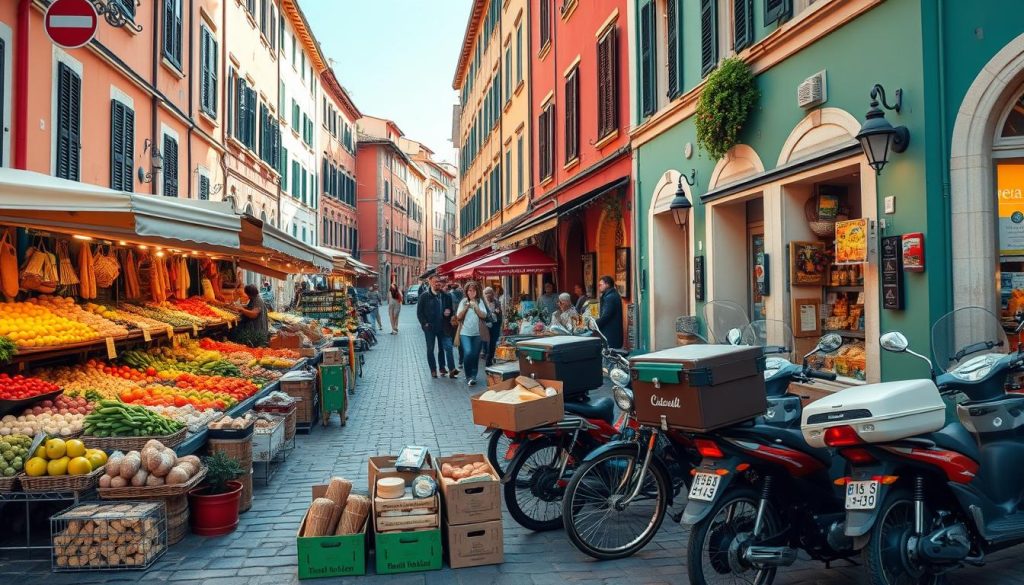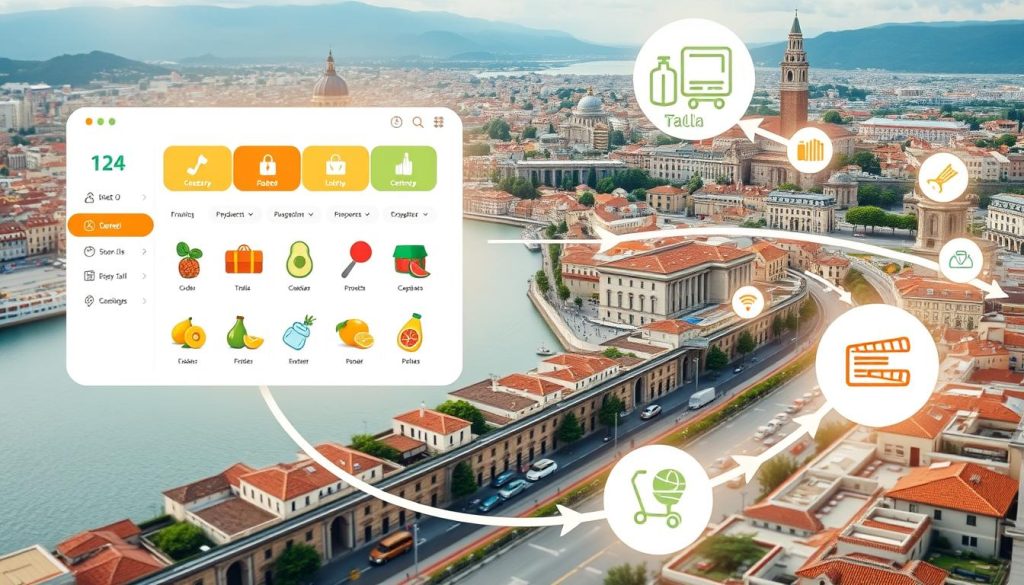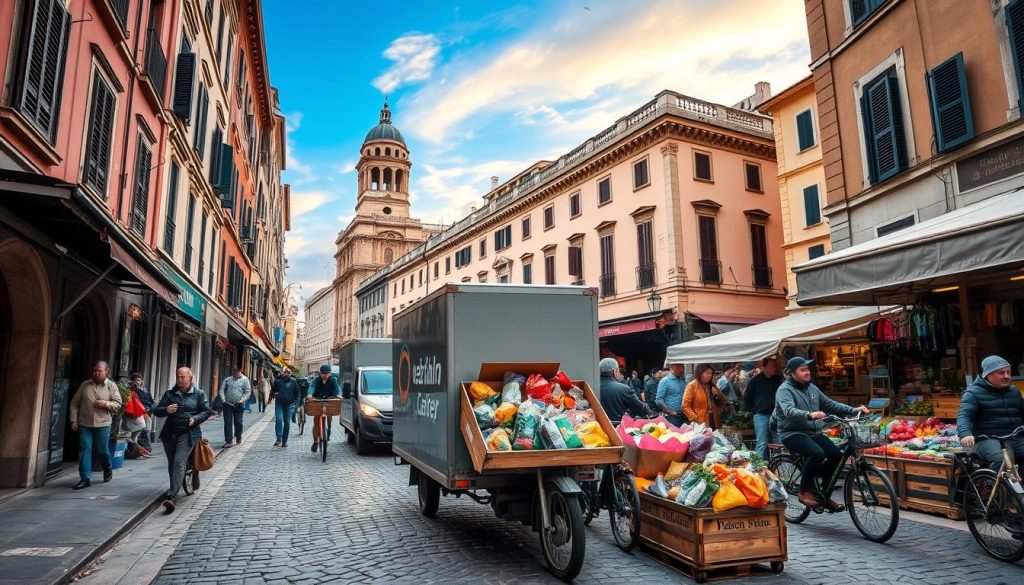“The greatest danger in times of turbulence is not the turbulence; it is to act with yesterday’s logic.” — Peter Drucker. This quote shows the importance of staying current in today’s fast-changing world. Starting a grocery delivery service in Italy is a great chance to adapt and innovate.
The demand for easy shopping is rising in Italy. Launching a grocery delivery service could be a smart move. Knowing the Italian grocery market, spotting trends, and using smart entrepreneur tips can lead to success. We’ll share key insights to help you succeed in this exciting venture.
Key Takeaways
- Recognise the growing demand for convenience in grocery shopping.
- Understand the unique characteristics of the Italian grocery market.
- Embrace technology to streamline operations and enhance customer experience.
- Identify your target audience’s preferences and behaviours.
- Stay adaptable and innovative to navigate market changes effectively.
- Build strong relationships with suppliers and local farmers.
Understanding the Grocery Delivery Market in Italy

The grocery delivery market in Italy has seen big changes lately. More people are choosing online shopping, which has boosted demand for easy grocery delivery. The Italian National Institute of Statistics (ISTAT) shows the market has grown steadily, mirroring a global trend towards digital shopping.
What Italian shoppers want is key to the market’s success. They’re looking for local and organic food. Companies like Glovo and Just Eat have noticed this, offering services that meet these needs. This shows a big change, where people want quality and sustainability as much as convenience.
Recent studies by Nielsen reveal important facts. They show that many different groups are interested in online grocery shopping. As the market keeps growing, it’s vital for businesses to understand these changes to succeed in Italy’s grocery delivery market.
Key Benefits of Starting a Grocery Delivery Service

More people want convenience, especially when it comes to grocery shopping. Busy lives mean less time for shopping, making delivery services very appealing. Starting a grocery delivery service can meet this growing need.
There’s also a chance for higher profits in the grocery delivery business. By improving supply chains and cutting costs, businesses can make more money than traditional stores. Offering special products or catering to specific markets can also boost earnings.
Working with local producers adds value to grocery delivery services. It builds community ties and attracts those who prefer sustainable, local products. For example, Supermercato24 shows how local products can increase customer loyalty.
In short, starting a grocery delivery service offers many benefits. It meets consumer needs, increases profits, and supports local businesses. These points highlight the advantages of this business model, setting the stage for success.
Market Research: Identifying Your Target Audience

Knowing who to serve is key for a successful grocery delivery service. By segmenting the market, businesses can offer what specific groups want. This means looking at age, lifestyle, and how people shop.
Tools for market research give deep insights into what customers need and like. Surveys and interviews collect important details. Meanwhile, looking at what competitors do can show what works well.
Companies like Mintel use detailed methods to understand what people want. This shows how crucial it is to do thorough research.
Here are some important groups to focus on:
- Young professionals who value convenience
- Families looking for ways to save time
- People who care about health and want organic food
By knowing these groups, a grocery delivery service can make better marketing plans. It can also improve its products. Understanding what people want helps a business grow and keep customers happy.
Essential Legal Requirements for Food Delivery Businesses

Starting a grocery delivery service in Italy means you must follow many legal rules. Getting the right business licences is key. It lets you operate legally. Without them, you could face big fines or even shut down.
It’s vital to follow food safety rules to keep customers safe and your service good. Knowing the local laws about food handling and delivery helps avoid legal trouble. Each item must meet food safety standards from the supplier to the customer.
Knowing the delivery laws is also important for success. These laws can change by area. They cover things like what vehicles you can use, who can drive, and when you can deliver. Before starting, learn all about these laws to build a strong base for your business.
- Make sure you have all the needed business licences.
- Learn about the food safety rules that apply.
- Know the local delivery laws and what you must do to follow them.
By taking these legal steps seriously, you build trust with your customers. This is good for your business.
Finding the Right Suppliers for Your Grocery Delivery Service

Finding top-quality products is key for a great grocery delivery service. You have to choose between local and national suppliers. Each has its own benefits and drawbacks.
Choosing Local vs. National Suppliers
Local suppliers give you fresher produce and products that show off the local culture. This can make your service more appealing, especially to those who want to support local businesses and the environment. However, local suppliers might not have as much variety or availability, so you might need to work with several.
National suppliers, though, offer a broader range of products. This means you can cater to more customers. Their logistics are usually reliable. But, you might have to compromise on freshness, which could disappoint some customers.
Building Strong Relationships with Farmers
It’s crucial to build strong ties with local farmers for consistent quality. Directly working with farmers can build trust and transparency. Regular talks help create strong partnerships and solve any supply problems.
Look at examples like Italy’s Slow Food movement for inspiration. It shows how effective partnerships can be in sourcing groceries.
Choosing the Best Delivery Model for Your Business

Creating an efficient delivery model is key for a grocery delivery service’s success. Deciding between same-day and scheduled deliveries impacts customer happiness and logistics. Also, picking between handling it yourself or using third-party logistics affects costs, flexibility, and efficiency.
Same-Day Delivery vs. Scheduled Deliveries
Same-day delivery is popular for its convenience and speed. It meets customers’ urgent needs, boosting sales and loyalty. To succeed, it needs advanced logistics to ensure orders are delivered on time.
Scheduled deliveries, on the other hand, help plan routes and use resources better. It’s good for cutting costs and leads to a more organised workflow. This model is great for retailers wanting to save money.
In-House Vs. Third-Party Delivery Services
Deciding between in-house and third-party delivery is crucial. In-house delivery gives you control over logistics. You can ensure service quality but managing a fleet is costly and requires a big investment.
Third-party logistics, like Deliveroo, offer insights into performance and customer satisfaction. They help expand your reach without the need for a large logistics network. Partnering with them lets you focus on your core business while benefiting from their expertise.
Creating an Efficient Order Management System

Setting up a good order management system is key for any grocery delivery service. It makes operations smoother and improves customer satisfaction. E-commerce integration is crucial, helping manage orders across different platforms.
Integration with E-commerce Platforms
E-commerce integration links your system with platforms like Shopify and WooCommerce. It updates stock levels, order statuses, and customer info automatically. A well-connected system cuts down on mistakes and speeds up order delivery, keeping customers happy.
Inventory Management Best Practices
Good inventory management is vital for your success. Using just-in-time inventory management keeps stock levels low but ensures items are always available. Regular checks and data analysis help predict demand, leading to cost savings and happier customers.
Marketing Strategies to Promote Your Grocery Delivery Service

Effective marketing is key for any grocery delivery service’s success. This field needs to be seen and interacted with. Using modern marketing tools and special offers can boost your service’s visibility. A well-rounded strategy will grab new customers’ attention and keep existing ones coming back.
Utilising Social Media Effectively
Social media is a strong marketing tool. By engaging on platforms like Instagram and Facebook, your service can show off its products. Eye-catching images and videos of fresh food and meals make your service more attractive. Targeted ads also help reach the right people.
- Post often to keep followers interested and build a community.
- Work with local influencers who share your brand’s values.
- Run contests and giveaways to get followers to share their experiences.
Offering Promotions and Discounts
Using promotions can spark interest and build loyalty. Discounts for first-time orders are a great way to attract new customers. Loyalty programmes reward regular shoppers, helping keep them coming back. Learning from successful local Italian grocery startups can offer valuable insights.
- Give seasonal discounts to boost orders during busy times.
- Offer referral bonuses to encourage people to tell their friends.
- Bundle products for a better deal.
Building an Online Presence for Your Grocery Delivery Business

A strong online presence is key for any grocery delivery service today. A good website is the base, giving customers info on services, products, and delivery. It should be easy to use, work well on mobiles, and be easy to find online.
Social media is vital for connecting with your audience. Posting about deals, new items, and community events can build loyalty. Use sites like Facebook, Instagram, and Twitter to grow your community. Content that speaks to your audience boosts your visibility.
SEO is crucial for better search rankings. Use local keywords to draw in nearby customers. Look at sites like Glovo and Carrefour in Italy for success. They show how a strong website and social media work together.
Understanding Logistic Challenges in Italy

Italy has its own set of logistics challenges that make grocery delivery tricky. The country’s varied landscape, with mountains and islands, makes planning routes hard. Also, traffic jams in cities often slow down deliveries.
The state of Italy’s delivery systems is another issue. It’s a mix of old and new, causing problems. Plus, different rules in each region about transport and food safety can also get in the way. Companies need to find ways to overcome these obstacles to offer smooth grocery delivery.
To tackle these challenges, a smart plan is needed. Companies can improve delivery times by:
- Optimising delivery routes using advanced mapping technology
- Utilising local distribution centres to decrease transit times
- Investing in staff training for better handling of delivery logistics
Looking at what other logistics companies do can be helpful. Those that have found creative solutions show it’s possible to beat the challenges. This leads to happier customers and better business results.
Crafting Your Unique Selling Proposition (USP)

In the competitive grocery delivery market, having a strong unique selling proposition (USP) is key. A good USP helps businesses stand out by showing what makes them different. It should meet the needs of your target audience, highlighting what makes your service unique.
When crafting a USP, consider these strategies:
- Identify your market niche: Look for areas in the grocery delivery market that need more attention. Focus on specific groups, special diets, or products that are not well-covered.
- Understand your audience: Do deep research to find out what your potential customers value most. This will help you tailor your offerings and messages to their needs.
- Highlight unique features: Emphasise what makes your service different, like eco-friendly packaging or locally sourced products. Showing these unique features will help you stand out in the minds of consumers.
Looking at brands known for their unique positioning can be very helpful. For example, a premium grocery delivery service might focus on organic and artisanal products. This appeals to health-conscious consumers. By consistently sharing your unique selling proposition, you attract new customers and keep existing ones loyal.
How to Create a Sustainable Business Model

To build a sustainable grocery delivery service, you need a plan that covers both financial and ethical sides. Key principles are vital for a strong business base.
- Developing a Sustainable Business Model: Focus on integrating environmental and social governance (ESG) into operational practices, ensuring that decisions align with sustainability goals.
- Cost Management: Effective financial planning is essential. Identify areas for cost reduction without sacrificing quality, enabling profitability while adhering to sustainability commitments.
- Ethical Sourcing: Partner with suppliers who prioritise ethical practices. Implement sourcing strategies that promote fair trade, organic farming, and local producers, enhancing your brand’s reputation.
- Consumer Education: Engage customers by highlighting the importance of sustainability. Educating consumers about the benefits of supporting a sustainable business model can drive loyalty and advocacy.
- Innovation and Adaptability: Stay abreast of sustainable practices in your industry. Regularly review operations to incorporate innovations that enhance both financial and environmental performance.
By following these principles, your grocery delivery service can grow. It will also help the community and the environment.
Utilising Technology to Enhance Customer Experience

In today’s fast world, using technology in delivery services is key to better customer experiences. Many grocery delivery companies have adopted new tech solutions. These have greatly improved how they serve customers.
Mobile apps are crucial in this area. A good app makes ordering simple and quick. For example, some big Italian grocery delivery apps have easy-to-use designs and smart features. These include:
- Real-time order tracking
- Personalised recommendations from AI
- Easy ways for customers to give feedback
These tech tools boost customer happiness. Being able to track orders in real-time makes customers feel secure. AI suggestions also make shopping easier and more fun.
Companies that succeed use these technologies to engage and serve their customers well. By investing in apps and new tech, they meet and often beat their customers’ expectations. This focus on technology is essential for lasting success in the grocery delivery market.
Customer Service Best Practices in Grocery Delivery
Great grocery delivery services need top-notch customer service. They must have strong communication, quick responses, and handle feedback well. This makes customers happy and loyal.
Response Time and Communication
Being quick to respond is key for good customer service. Quick answers show you care. Using automated systems for basic questions helps staff focus on harder issues.
This ensures customers get updates on time. It makes the delivery experience better.
Handling Customer Feedback and Complaints
Dealing with feedback and complaints is vital for better service. Asking for feedback helps fix problems. It shows customers their opinions count.
Having a clear process for complaints builds trust. It shows you value their thoughts. This helps improve your service over time.
Scaling Your Grocery Delivery Service

To grow a grocery delivery service, you need to make smart choices. First, build a strong customer base. Then, think about expanding your business. This can make your service more popular and profitable.
Increasing the areas you serve and adding more products are key. These steps will help your business grow and stay strong.
Expanding Your Delivery Area
Expanding where you deliver is a smart move. Try delivering to new places to see if people want your service. Here are some tips:
- Do a market study to find out where people want your service
- Start small by testing in a few areas
- Listen to what your customers say to make your service better
Adding Product Lines and Services
Adding more products is another way to grow. You could sell fresh food, organic items, or even ready-to-eat meals. This meets what customers want and keeps them coming back. Here’s what to do:
- Find out what your customers want to buy
- Work with local suppliers to get the best quality
- Advertise your new products well to get people excited
Financial Planning and Budgeting for Your Delivery Service
Effective financial planning is key for any grocery delivery service’s success. A structured budget and cost analysis can boost financial performance. Begin by creating a detailed budget that includes all expected costs.
Using budgeting tools can help manage finances. QuickBooks or Xero can track expenses and income, allowing for quick changes. Make forecasts to spot cash flow problems early and solve them fast. Here are important parts of your financial plan:
- Initial start-up costs, like technology setup and initial inventory.
- Fixed costs, including rent and utilities.
- Variable costs related to delivery logistics and staffing.
- Potential income streams outside direct grocery deliveries.
Regular cost analysis is vital for smart financial decisions. Always check your expenses and look for ways to save. This keeps your finances healthy and supports growth.
Success Stories: Inspiring Examples from Italy
The grocery delivery scene in Italy has grown a lot. Many success stories inspire new businesses. Cortilia stands out for its focus on local produce. They source products from nearby farms, boosting local economies and gaining customer trust.
Supermercato24 is another success story. They use technology and efficient logistics to stand out. Their system ensures fresh products are delivered quickly, showing the power of innovation in grocery delivery.
These stories show what’s possible in the grocery delivery market. They prove that with the right strategies, entrepreneurs can succeed. They inspire others to find their place in this fast-changing industry.









